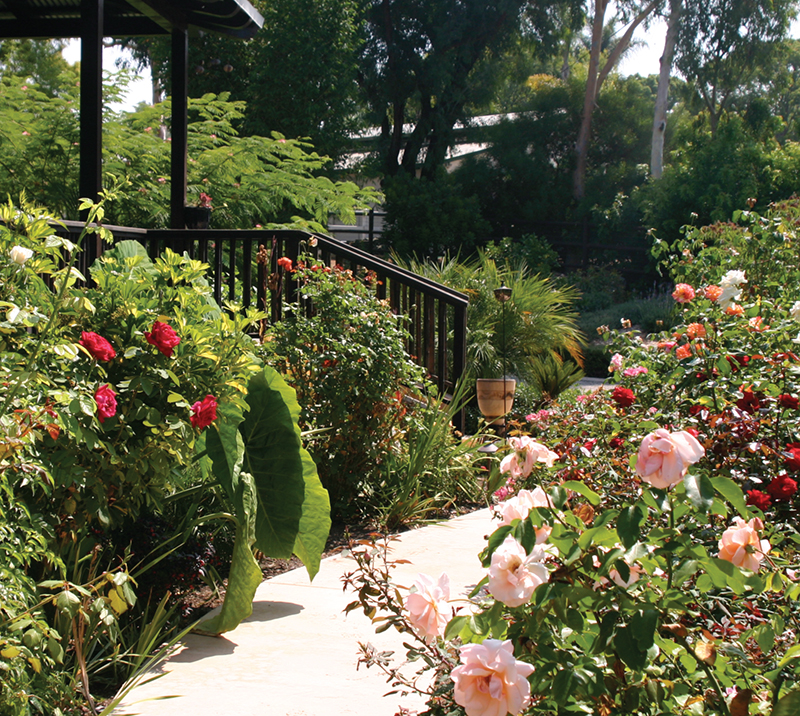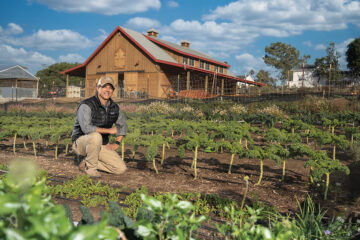How Does My Garden Grow?

How Does My Garden Grow?
Driving the winding roads of Rancho Santa Fe is always a beautiful drive, but nowadays, it’s also sobering. Things are really dry, and with Santa Ana season almost here, it’s hard to put the past out of mind. El Niño is back, and the race is on between flames and rain. I’m rooting for rain, as one of the people who counts the drops to make sure there is enough water to go around.
We’re in a heck of a pickle here in the Southwest. The faucet is down to a drip and unless we fix it soon, the best spot in the country may no longer support the lifestyle we take for granted.
Much of the water we use in San Diego starts its journey to the tap in Northern Colorado, the headwaters of the Colorado River. All that snowmelt flows southwest for nearly 1,500 miles, draining water from a quarter-million acres before dwindling into a trickle just shy of the Sea of Cortez (also known as the Gulf of California).
The Colorado River stalls behind 20 dams along its stretch. The biggest and best known is the Hoover Dam, holding back Lake Mead and the Glenn Canyon Dam at the south end of Lake Powell. The water is grabbed as it goes — some to Colorado’s cities and farms, more for Las Vegas, Phoenix, and Tucson, and the lion’s share to L.A.’s Metropolitan Water District and its 18 million customers.

What is the real cost of that water? The answer is hidden in remote areas of extreme Southern California and Northern Mexico in the 2 million-acre Colorado River Delta, which, less than a century ago, was described by explorer Godfrey Sykes as a wetland jungle, with 90-foot trees of Amazonian proportion. It was land incredibly rich in native and migratory wildlife. Waterfowl of every description filled the skies and water, jaguars roamed there, and the sky sparkled with brightly-colored native parrots. Water flooded south, from Rocky Mountain snowmelt and the huge summer thunderstorms (in seemingly endless quantity in those days), transporting 160 million metric tons of nutrient-rich sediment along with it.
That water rarely makes it to the sea these days. As a result, the upper gulf is in deteriorating condition and unable to support the rich diversity of life that once thrived in its warm water and in its delta. The Colorado River delta is mostly dried up and built over, and the gulf waters remain turbid as the tides erode eons of sediment. A century ago there were 25-50 delta clams per square meter, now there are three per square meter. That little mollusk is only one of a growing number of species endangered or threatened by the loss of Colorado River water.
The river water is tapped out, and still, the only thing slowing growth in the Southwest is the economy. Serious conversations are finally starting about just how we will carry on with a drier climate and a lot less water.
As an avid organic gardener I take my water very seriously. Two years ago, I installed a 1,100-gallon tank to hold rainwater that sheds off our home’s roof and flows into drains, and then gets pumped into my tank. One good rain of a 1/4-inch or so will fill it.
Last winter’s rains came in pulses — a couple good rains and a month of dry weather, and then the pattern repeated itself. I was able to irrigate using stored rainwater during the dry spells

Our system cost about $1,000, but you can get by cheaper by just placing trashcans or rain barrels under eaves and rain gutters. Even if we just use the rain to water houseplants there is at least a small saving.
Taking it one step further, though, we are conserving much more water by changing the way our home irrigation system works. There are now commercially available weather stations that easily attach to sprinkler control units. The gadgets work by staring at the sky and using hour-by-hour weather conditions to tailor water times to what plants actually need based on the changing climate.
We are also switching out the heads on sprinklers to the new lower-flow sprinkler heads. They put out less water and are far more efficient than typical sprinkler heads that spray water about three times faster than the ground can absorb it. Combining new sprinkler heads with integrated irrigation weather stations cuts outdoor water use in half.

Too much of the water intended for our gardens ends up in street gutters. Startling visual proof of the waste can easily be seen in parts of San Diego’s North County. Escondido Creek flows from Lake Wolford north of Escondido all the way to the San Elijo Lagoon in Cardiff-by-the-Sea. In spots the creek is 20-feet wide and four-feet deep. In dry months, 98 percent of the water flowing in Escondido Creek is irrigation runoff.
So we sit, and we wait for the winter rains to fall, hoping for enough of it to fill the lakes and reservoirs with water, the mountains with snow, and put off shortages one more year.
While we are still actively debating among ourselves the human role in climate change, it’s become abundantly clear that the human role in conserving water, in a drier climate, is essential, if we are going to have enough to go around. LOREN NANCARROW





Comments